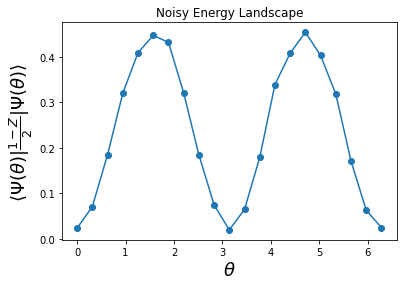Zero Noise Extrapolation with pyQuil and parametric compilation#
In this example we demonstrate how to use Zero Noise Extrapolation (ZNE) in Mitiq with a parametrically compiled program in pyQuil. Parametric compilation saves time by compiling the program ansatz once, instead of compiling each time the parameters are updated. In pyQuil, a memory_map argument is used to substitute in values for previously-declared Quil variables in the pre-compiled executable.
When adding the noise mitigation function zne.execute_with_zne the memory_map is still passed to the executor function and the circuit parameters are updated without the need for repeated compilation.
The example shown here is adapted from the pyQuil parametric compilation tutorial.
import numpy as np
from pyquil import get_qc, Program
from pyquil.gates import RX, RY, H, CNOT, MEASURE
import mitiq
from mitiq import zne
from scipy import optimize
Use the get_qc command to initialize the simulated noisy device where the PyQuil program will run.
# initialize the quantum device
qc = get_qc("2q-noisy-qvm")
Set up the quantum circuit
program = Program()
theta = program.declare("theta", memory_type="REAL")
ro = program.declare("ro", memory_type="BIT", memory_size=1)
program += RX(theta, 0)
program += RY(theta, 0)
program += RX(theta, 1)
program += RY(theta, 1)
program += H(0)
program += CNOT(1,0)
program += H(0)
program += MEASURE(0, ro[0])
Mitiq’s zne.execute_with_zne function takes a quantum program (e.g. PyQuil program)
and an executor function as arguments. The executor function must output the expectation value
resulting from running the quantum program.
def expectation(theta, executable: Program) -> float:
bitstrings = qc.run(
executable.write_memory(region_name="theta", value=theta)
).readout_data.get("ro")
result = np.mean(bitstrings[:, 0])
return result
Run the parameter scan without noise mitigation
program.wrap_in_numshots_loop(1000)
quil_prog = qc.compiler.quil_to_native_quil(program, protoquil=True)
thetas = np.linspace(0, 2 * np.pi, 21)
results = []
for theta in thetas:
results.append(expectation(theta, quil_prog))
Plot the energy landscape without noise mitigation
from matplotlib import pyplot as plt
_ = plt.figure(1)
_ = plt.plot(thetas, results, 'o-')
_ = plt.xlabel(r'$\theta$', fontsize=18)
_ = plt.ylabel(r'$\langle \Psi(\theta) | \frac{1 - Z}{2} | \Psi(\theta) \rangle$', fontsize=18)
_ = plt.title('Noisy Energy Landscape')
plt.show()

Run optimization without noise mitigation
quil_prog = qc.compiler.quil_to_native_quil(program, protoquil=True)
init_angle = [0.1]
res = optimize.minimize(expectation, init_angle, args=(quil_prog), method='COBYLA')
print(res)
fun: 0.021
maxcv: 0.0
message: 'Optimization terminated successfully.'
nfev: 20
status: 1
success: True
x: array([-0.08955312])
Now run parameter scan with ZNE
quil_prog = qc.compiler.quil_to_native_quil(program, protoquil=True)
init_angle = [0.1]
results_zne = []
# here we use a linear fit for the zero noise extrapolation
fac = mitiq.zne.inference.LinearFactory(scale_factors=[1.0, 3.0])
for theta in thetas:
results_zne.append(
zne.execute_with_zne(quil_prog, lambda p: expectation(theta, p), factory=fac)
)
Plot the energy landscape with ZNE
_ = plt.figure(2)
_ = plt.plot(thetas, results_zne, 'o-')
_ = plt.xlabel(r'$\theta$', fontsize=18)
_ = plt.ylabel(r'$\langle \Psi(\theta) | \frac{1 - Z}{2} | \Psi(\theta) \rangle$', fontsize=18)
_ = plt.title('Mitigated Energy Landscape')
plt.show()

Run optimization with ZNE
def mitigated_expectation(thetas, executable: Program, factory) -> float:
mitigated_exp = zne.execute_with_zne(quil_prog, lambda p: expectation(thetas, p), factory=factory)
return mitigated_exp
quil_prog = qc.compiler.quil_to_native_quil(program, protoquil=True)
res_zne = optimize.minimize(mitigated_expectation, init_angle, args=(quil_prog, fac), method='COBYLA')
print(res_zne)
fun: 0.016000000000000007
maxcv: 0.0
message: 'Optimization terminated successfully.'
nfev: 20
status: 1
success: True
x: array([-0.04267812])
References#
[1] Parametric compilation tutorial in pyQuil.
display information about Mitiq, packages, and Python version/platform
mitiq.about()
Mitiq: A Python toolkit for implementing error mitigation on quantum computers
==============================================================================
Authored by: Mitiq team, 2020 & later (https://github.com/unitaryfund/mitiq)
Mitiq Version: 0.13.0dev
Core Dependencies
-----------------
Cirq Version: 0.13.1
NumPy Version: 1.20.3
SciPy Version: 1.7.3
Optional Dependencies
---------------------
PyQuil Version: 3.0.1
Qiskit Version: 0.32.1
Braket Version: 1.14.0
Python Version: 3.7.7
Platform Info: Linux (x86_64)
